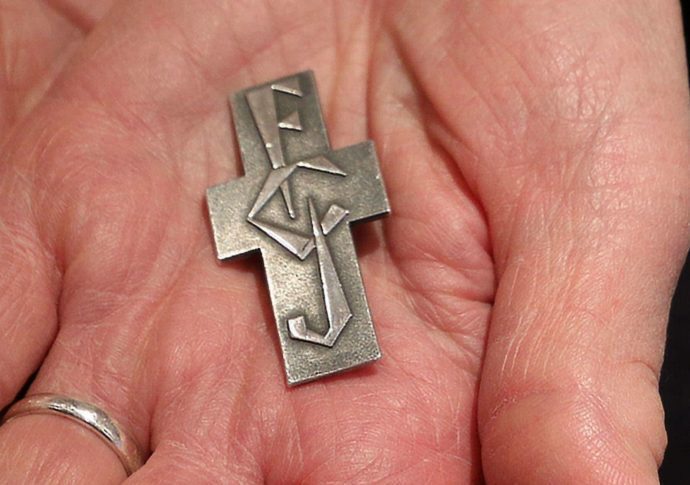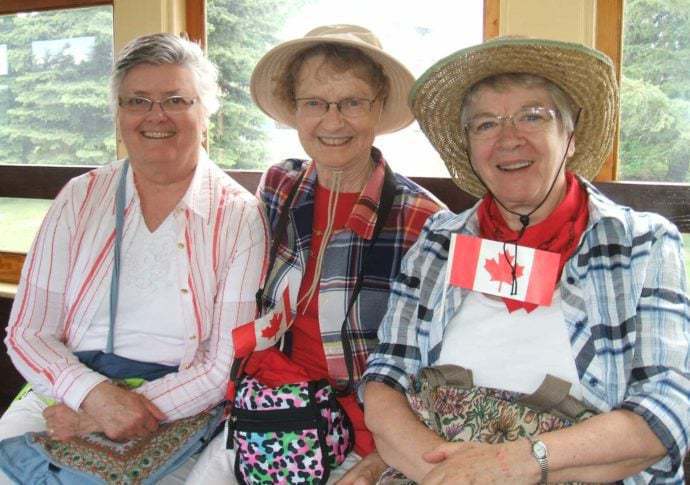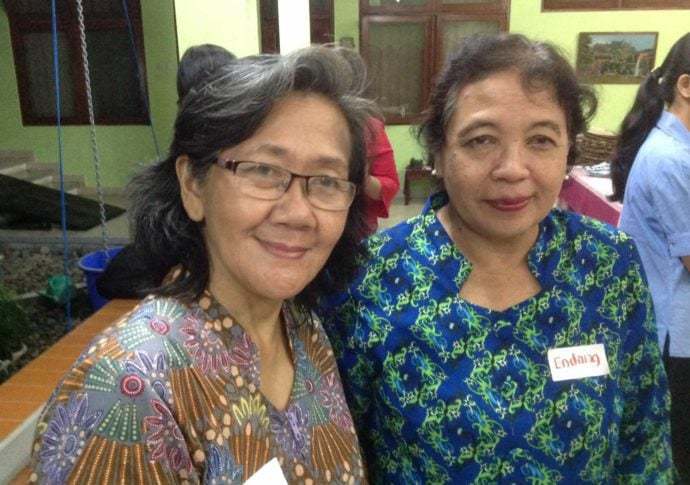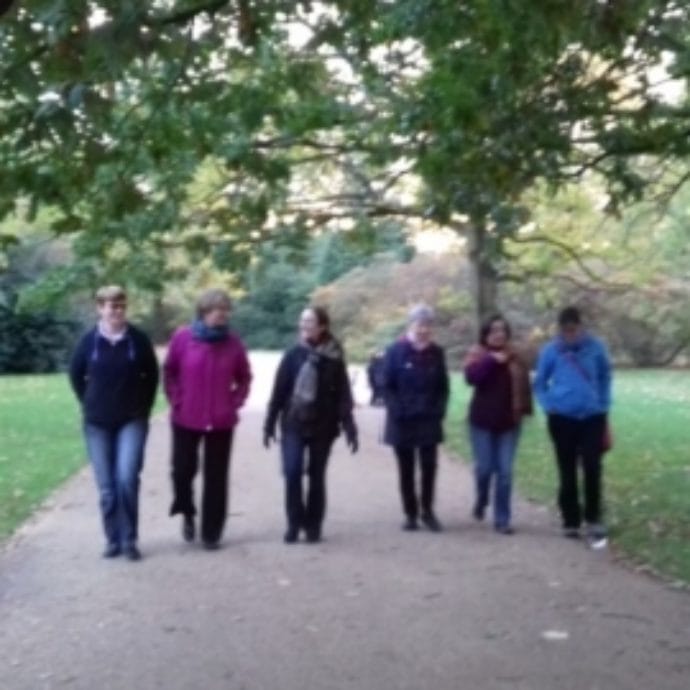Americas History

Americas History
Our FCJ History in the Americas
We include here a brief account of the story of the FCJ journey to and within the Americas – Canada, USA and Latin America – as well as a timeline of the major events in this history.
From Europe to the Americas
FCJ Sisters have been in the Americas since 1883.
In 1882 Mother Josephine Petit, then General Superior of our FCJ Society received a request from Bishop Vital Grandin OMI to send Sisters to begin a foundation in Western Canada. She responded positively, and the first group of Sisters came to Canada in 1883.
In her letter of acceptance, she wrote:
The journey will be long, difficult, costly and even dangerous… Your poverty does not permit you to pay our traveling expenses. You ask for sacrifices. Well, we will do it for God.
Canada
Eight Sisters left Liverpool, England, on May 10, 1883. They journeyed by boat, the Peruvian, across the Atlantic for eleven days. After a day in Quebec City, they travelled to Montreal on the train and stayed for some days at the Grey Nuns’ Motherhouse, a building that had been completed in 1871.

Sketches by first FCJs as part of the diary of their journey. Scene on Deck, May 15th 1883
In Montreal the Sisters visited different convents and schools before taking the train to Winnipeg together with the Bishop and some Oblate students and novices.

Sketch of the journey by train. The Bishop is handing out figs!
To cross the St Claire River from Sarnia (Canada) to Port Huron (USA) the train was divided into three large sections. Each section was placed on a large flat ferry boat which steamed across the river in about half an hour. On June 11, the travelers left the train at Qu’Appelle, Saskatchewan and continued their journey in covered wagons.

Waiting for the horses before setting off. June 15, 1883
En route the Bishop told the sisters, In reading the life of your Foundress I see that the spirit of poverty and humility has presided over all your foundations. [In this diocese] you must expect the poverty and humiliation of a small beginning, but God will be with you, you are his faithful Companions… What an amount of good you have to do!
You must expect the poverty and humiliation of a small beginning, but God will be with you, you are his faithful Companions… What an amount of good you have to do!

Sketch of the house in St. Laurent
In the evening of June 28, after crossing the Saskatchewan river on a barge and enjoying to the full, the beauty of the country before them, the Sisters arrived at St. Laurent and were welcomed to their future home, a cottage with no chairs or beds. We slept on the floor on our rugs and certainly cannot say that they were as soft as we found our beds on the prairies.
Two days later, the Sisters who had completed their journey in St. Laurent watched as the band of four FCJs winding their way down the pretty road leading to Prince Albert disappeared from view. The scenery was beautiful and the flowers more abundant than ever … We shall never forget our last dinner on the prairie; the heat of the sun seemed sufficient to cook our dinner without the aid of the fire.
The little community of Prince Albert, four in number, reached its destination on the evening of the same day, June 30, 1883.

The house in Prince Albert
The Sisters wrote: when we first arrived we were disappointed to find that our Sisters in St. Laurent were to be separated from us by a distance of about 40 miles, as we thought we would be able to see each other occasionally. It is true that in this country 40 miles is considered nothing but we have no means of conveyance and it would be a great expense to hire a vehicle.
Still we have been in constant communication with them, caravans set out nearly every week from St. Laurent and Prince Albert to Winnipeg and once weekly postal service has been regular from the first day of our arrival. At present, there is no communication by rail; we are deprived of a great many temporal advantages, and we wait two long months before receiving an answer to our letters from Mother Josephine. The telegraph is going to be set up soon and there is hope that the railway will commence next year. Our dear pupils returned on January 7, determined to make good use of their time at school. One new boarder and several day scholars were added to our number.
The first communion day at the school was a beautiful and lovely feast. The hearts of the children were very pure and they longed so much to receive the Sacrament. For many weeks before this happy day, they counted the days and hours until their communion day.
In Spring when the melting snow made the crossing of the river impossible, a little girl, 10 years of age, fearing to miss her catechism lesson, and so not to make her First Communion, begged her parents to sell her little cow (to which she was greatly attached) in order that she might attend our school. Among our boarders we have a little orphan, a little girl of three years of age, who is of French, English, Cree, Saulteux and Assiniboine descent. This dear child charms everybody by her simple piety.
Meanwhile, in the 1884 annals of St. Laurent the Sisters wrote: On the Sunday after Easter, twenty children received communion for the first time.
The year 1885 was the time of the Northwest Rebellion. In Prince Albert the Sisters wrote: We shall long remember the feast of St. Joseph 1885 for it was on that day that the standard of rebellion was raised and a few days later the town was threatened with an attack from the rebels. Who could tell our fears and anxiety for ourselves and our Sisters in St. Laurent during the two months in which we lived in constant dread of attack. But God watched over us in a special manner and we were preserved from the many and imminent perils of which we were surrounded. At last, on the 14th of May, we had the consolation of knowing that our dear Sisters of St. Laurent were safe and well.
A little of their anxiety can be felt in the annals of St. Laurent: we learned the father of one of our children had been arrested and condemned to death because he refused to take part in the rebellion. The large store in Duck Lake had been pillaged and then burned. Other items of bad news followed in succession, and all we could do was to share the sadness of our children, praying the Rosary and making the Stations of the Cross continually.
On July 11, 1885, the FCJ sisters left St. Laurent to establish a school in Calgary, Alberta. Welcomed in Calgary on July 26, 1885, the Sisters were given the Oblate Fathers’ home as their residence and immediately prepared to open their doors to children for classes that September.

“Mother Mary Greene” by Gabriele F. Lynch, 1995
From the beginning, Mother Mary Greene, the superior at Sacred Heart Convent and Principal of Sacred Heart Convent and Boarding School, worked to gain government recognition. The education standards of the school were such that on December 18, 1885, what eventually came to be called the Calgary Catholic School District, the first school district in Alberta, came into existence.
Another group of missionary FCJs was sent from Liverpool on September 13, 1883 to Brandon, Manitoba.

They spent a few days at St. Boniface. A Fr. MacCarthy greeted them on behalf of Archbishop Taché. He gave us a curriculum for the classes we would be starting, and even procured the necessary books with which to start. He assures us at Brandon we had complete freedom in Catholic teaching because a law had been passed by which His Grace has full and complete authority over Catholic studies. He is the absolute master and protector, the Protestants have nothing to do with it. Furthermore, here, like everywhere else in Canada, all social classes (rank) are mixed in education, thus the daughter of the poorest labourer would be seated, without distinction, next to the daughter of the richest middle class person. All receive the same instruction.
At last, Monday, 8 October (1883) at a quarter to nine, the bell called the children and at 9 classes began. Only fifteen children, boys and girls, Catholic and Protestants, had arrived on time…. We taught them catechism, bible stories, reading, writing, grammar, geography, arithmetic, French and singing, and we noticed day by day that everything was new to them… Since October the number of day pupils has risen to more than 50. We have been notified of several boarders but the cold weather has kept them at home until spring.
The school in Brandon prospered for some time, but in 1887 things began to change… discrimination against Catholics became more pronounced. It was difficult for Catholics to hold any kind of office or even obtain a job. Also in 1887 the convent, which had been tax exempt as were religious houses elsewhere in Manitoba, was required to pay taxes on the property. Manitoba school laws became more severe and more difficult to cope with. As a result the Sisters moved to Fond du Lac, Wisconsin and eventually, a year later to Fitchburg, Massachussetts.
On August 9, 1888, another party of twelve Sisters left Liverpool for Canada. After ten days travel they arrived safely in Quebec. The Grey Sisters, as usual, were exceptionally hospitable towards them. The FCJ party boarded the train on August 20 headed for Brandon, and from Brandon four of the travelling companions left for Prince Albert, two remained at Brandon, and six travelled on to Calgary where they arrived much fatigued on August 25.
On October 1st, 1888, after a few weeks with their Sisters in Calgary, five FCJs left Calgary with the good-byes and God-speeds of their Sisters ringing in their ears. They were followed by a long line of Red River wagons bearing their luggage; the household goods for their new home; the vestments, vessels, and ornaments to be used at Holy Mass and last, but by no means least, food for the journey and a couple of crates of hens and a rooster. The ride over the prairie would take ten days during which time they were alone on these vast stretches of uninhabited country, with scarcely a house between Calgary and their destination, Edmonton.

Immaculate Conception Convent, Edmonton, 1892 - 1967
In 1890, five Sisters from Prince Albert, Edmonton and Calgary met at a small coal trading post called Dunmore, east of Medicine Hat. As early as 1885, Dunmore had a narrow-gauge railway. Sometimes, at night, a fairly comfortable passenger-coach was attached to the coal trucks but since our Sisters were advised to travel by day, they used the guard’s van at the end of the twenty or so coal cars for their first, smutty, bumpy ride of 100 miles to their new mission in Lethbridge. Arriving earlier than was expected, the Sisters made their way to the Church where Our Divine Lord was the first to welcome them.
The Sisters quickly made themselves at home in the school room. There were no beds and no bedsteads, the Sisters state in the Annals, so we put two desks together for a cozy bed and we gathered from our bundles all the clothing we could spare for covering.
Meanwhile there was a desire to have FCJ Sisters serve in Rat Portage, Ontario (now Kenora), a small town at one end of Lake of the Woods. Four FCJs moved to Rat Portage in August 1892. Classes began in September with an enrollment of seventy children but before Christmas their number had tripled and there was much difficulty in fitting them all into the limited space. Inspectors came and were satisfied with the work done. The pupils, our Sisters found, worked hard in their classes and equally hard at their play. After ten years, the FCJ Sisters left Rat Portage and the community was dispersed to other FCJ convents in Canada or the USA.

St. Michael School, Duck Lake
From January 1895 to July 1903, nine FCJ Sisters served in a residential school for indigenous children at Duck Lake, Saskatchewan, in the Northwest Territories named St. Michael’s School although not all were there at the same time. In a report to the Apostolic Delegate in August 1901, the Sister in charge stated that there were 73 children in the school and the subjects that were taught (all through English) were Catechism, History, Health, Reading, Writing, Arithmetic, Canadian History and French.
The school appeared to do well, was praised by visitors (including the Governor General and the Prime Minister), winning medals at local and provincial exhibitions and receiving two medals from the French Government received nothing but criticism from the Government Inspector in his annual report. The Sisters were confused by this and the General Superior, suggesting that our Sisters were not trained for the work that was required and that Sisters from a Canadian community would probably have a better idea how to operate, decided to withdraw the Sisters from Duck Lake. Once twelve Sisters of the Presentation arrived in Duck Lake on July 3, 1903, the FCJ Sisters were able to leave on July 6.

It was 1948 before the FCJs established a convent in central Canada when seven Sisters arrived in Combermere, Ontario in mid-August. Around 1965 the enrollment reached a peak of about two hundred boarding and day students, including some non-Catholics. The convent and school in Combermere closed in 1974.
In 1950 the Archbishop of Toronto, Ontario invited the FCJ Sisters to teach in their diocese. The sisters were also looking for a foundation in a Catholic university town where their young sisters could be educated. In 1951, the first FCJ house was opened in Toronto. Over the years the Sisters have lived in several houses in Toronto where they ministered in elementary schools in the Weston area and in Madonna High School and St. Mary’s High School. Since 1990, a ministry with refugees has developed into the now well established FCJ Refugee Centre.
From 1966 to 1968 the FCJs operated a boarding school, Mary Mount, in Midnapore, Alberta, attended by girls who had been boarders in Calgary and Edmonton, as well as others. But even while effort was being put into developing the new school’s ‘spirit’, the FCJ Sisters were already asking: Is the boarding school situation right for Alberta girls today? Is this a situation where the Sisters can most effectively serve God and God’s people?
With the decision to close Mary Mount at the end of June 1968, a long and rich tradition of FCJ boarding schools in Alberta, dating back to 1885, came to an end. The adaptations required for a new era of change and renewal had begun.
In 1978-1980, the space occupied by the former boarding school at Sacred Heart Convent in Calgary was completely remodeled to create suitable space for the FCJ Christian Life Centre and in 2002 a new reception area was added to the east end of the building.

The FCJ Christian Life Centre, Calgary
From 1973 to 1982, FCJ Sisters ministered in the Parish School in Oyen, very near to the Alberta – Saskatchewan border.
In 1982 a small community opened in northeast Calgary on 9th Avenue that allowed us to increase our outreach to a local parish and be a novitiate setting for two young women. Most of the community worked at the FCJ Christian Life Centre.
In 1986, in response to a call from the Canadian Bishops for priests and religious to do what they could to answer some of the needs in the northern mission dioceses of Canada, FCJs were sent to New Hazelton, BC in Prince George Diocese. The Sisters ministered in the New Hazelton Catholic School until it closed and in the Parishes of New Hazelton and Moricetown. In 1991, the apostolate in Prince George Diocese was extended to Kitimat, where FCJs were involved in both school and parish until 2004. In 1998, when FCJs withdrew from New Hazelton, one Sister moved to the Moricetown Reserve where she ministered and also lived on the reserve until a community was formed in Smithers in 2003. Faithful Companions of Jesus remained in Smithers until 2012. (On May 15, 2018, the community of Moricetown Reserve reclaimed its original name of ‘Witset’ and is now known as ‘Witset First Nation’.)

Moricetown (Witset) BC, by Owen Lloyd (CC BY-SA 3.0, https://commons.wikimedia.org/w/index.php?curid=11564108)

Igloolik Winter after the sun has gone - White building by first power pole is the Church and Residence (CC BY-SA 2.5, https://en.wikipedia.org/w/index.php?curid=13004316)
From 1989 to until June 2000, another FCJ ministered in Churchill-Hudson Bay Diocese with the Inuit People of the Eastern Arctic, now called Nunavut. For most of this time, she lived in Igloolik.
An FCJ from Canada ministered in Bangalore, India from December 1988 until June 1996.
Another FCJ Sister served as a Campus Minister, first in Assumption University in Windsor, Ontario from 1994 to 1995; then at St. Thomas University in Fredericton, New Brunswick from 1996 to 2001. Two Canadian FCJ Sisters served in Kenema in Sierra Leone, one in Kenema from (1985-1994) and the other in Kailahun in 1982.
To extend the ministry of FCJ hospitality and care, a house was purchased near Sacred Heart Convent in Calgary in 2007. In the beginning, it provided a home-like, safe environment for live-in foreign nannies and care-givers on their days off. When that need lessened, the house was used to accommodate low income people with cancer, who had had a transplant and whose immunity was very low. In cooperation with Calgary Catholic Immigration and at the request of Pope Francis for religious to help with the Syrian refugee crisis, FCJ Sisters welcomed the first of four Syrian families in December 2016.

2019 barbecue at FCJ Christian Life Centre celebrating the presence of Syrian families
USA
When the house in Brandon closed in 1985, some of the Sisters moved to Fond du Lac, Wisconsin where they remained for one year. The earliest settlers in the town of Fond du Lac, situated south of Lake Winnebago, were undoubtedly French-Canadian. While in Fond du Lac, the Faithful Companions of Jesus from Brandon administered and staffed a French speaking school which had an enrollment of 100 children. The Annals recorded: Our modest success incurred the displeasure of the only other religious community in the town, which had a large German population. The Faithful Companions of Jesus left Fond du Lac in July 1896.
 In 1896, Father Vignon, Missionary of La Salette, pastor of St. Joseph’s Parish, Fitchburg, Massachusetts was seeking French-speaking sisters to teach in the new parish school which had an enrollment of 200 students.
In 1896, Father Vignon, Missionary of La Salette, pastor of St. Joseph’s Parish, Fitchburg, Massachusetts was seeking French-speaking sisters to teach in the new parish school which had an enrollment of 200 students.
The first small group of sisters arrived in Fitchburg on July 22, 1896, to be joined a few days later by other sisters from Fond du Lac. Their home was on the third floor of the school. We occupy a superb building situated on an eminence, surrounded by wooded heights…. St. Joseph’s Parish is peopled exclusively by French Canadians who have preserved their native tongue. The faith of the children is so beautiful, so simple, their regard for us so great, their docility so touching, they make our work and our burden very light.
Besides giving their energies to a full day in the classroom, the sisters devoted evenings and weekends to the Sodalities of the Children of Mary, of St. Anne and of the Sacred Heart. Soon they saw the need for religious instruction of the boys and girls of the parish who worked in the factories or who attended public school. As well they received numerous requests for lessons in music, drawing, painting, art, embroidery, needlework, singing and French.
In 1898, six postulants received the habit in Fitchburg and left for the novitiate, St. Anne d’Auray, Brittany. Over the years many other women followed in their footsteps.
A new convent was built in 1900, which became St. Joseph Academy, a private boarding and day school for girls. It was closed in 1925. The parish school enrollment peaked in 1933 with an enrollment of 1,500 with a teaching staff of thirty FCJ Sisters. When the Sisters moved from the convent to the converted St. Joseph’s Rectory in 1975, they continued to administer and to teach in St. Joseph’s School until 1982, when the decision was made to withdraw from Fitchburg.

Gilbertville, Massachusetts was a small textile manufacturing centre forty miles from Fitchburg. When the Sisters of Mercy withdrew from St. Aloysius school in 1908, the FCJs from Fitchburg were invited to take their place. On August 16, 1909, six FCJs arrived in Gilbertville. They taught in the school and provided religious instruction in the neighbouring towns of Hardwick and South Barre. As the Catholic population decreased due to the closing of the wool and lumber mills, the enrollment in the school also decreased and by 1951 the FCJ community left Gilbertville.
In 1922 Bishop William Hickey of Providence, Rhode Island, saw the pressing need for parochial schools in his diocese. Since Father Doran of Blessed Sacrament Parish knew the Faithful Companions of Jesus when he was pastor in Gilbertville, Massachusetts, he invited them to Providence. On August 22, 1922, five sisters took up residence at 75 Andem Street. The FCJs undertook the religious instruction of 1,100 children who were attending public school. The sisters also took care of the church sacristy, trained altar servers, and made altar breads.

Blessed Sacrament Convent and School, Providence, Rhode Island
On September 13, 1925, the new Blessed Sacrament School opened with 454 children enrolled and ten FCJs on staff. Parish records indicate that the Faithful Companions of Jesus contributed as many as thirty sisters each year to the school for fifty years.
St. Patrick’s High School for Girls in Providence was opened on September 11, 1933. Over the years the school developed an excellent reputation for its overall Christian educational program. In 1969 the State condemned the building, and St. Patrick’s High School was relocated in St. Lawrence Parish in North Providence. This move had serious consequences for staff and students, and eventually, in 1984, the Diocese decided to amalgamate St. Patrick’s High School with the boys’ High School, LaSalle Academy.
With the renewal of religious life in the 1970’s the Sisters became involved in all aspects of parish life. As the number of Sisters became fewer, the community moved out of the large convent on Atkins Street to Mount Pleasant Avenue. Other houses in the Providence area were rented, or purchased and sold, as the needs of the community and their ministries changed.
St. Philomena Convent, Portsmouth, Rhode Island opened in 1927 as a summer vacation home for the communities of Fitchburg, Gilbertville and Providence. For almost twenty-five years the Sisters came to this property on Cory’s Lane overlooking Narragansett Bay for days of quiet and rest. A small community took up residence at St. Philomena Convent in 1953 and started St. Philomena School, a small, private day school and boarding school.

The first St. Philomena Convent, Portsmouth, Rhode Island
A new building was built in 1965, and by the 1970’s some of the Sisters began to consider St. Philomena Convent as a home for their retirement years. St. Philomena School became a day school for Grades K-8; it continues to expand and to flourish. In 2021, the School became part of the Sacred Heart Network of Schools (RSCJ – Religious of the Sacred Heart of Jesus).

St. Philomena School, Portsmouth, Rhode Island
In 1986 a house was purchased in Fall River, Massachusetts. This community residence was close enough to Portsmouth to allow members of the community to be a support to the community and school there, as well as to be involved in other ministries.
Responding to apostolic needs and opportunities, the FCJ Society opened small communities in Tuscaloosa, Alabama (1993-2018), Durham, North Carolina (1996 to 2013), Kingstree, South Carolina (1999-2002), and Oakland, California (1996 on).
Argentina

The first FCJ Sister to live and work in South America was from the United States. In 1985, she established a base in Córdoba, Argentina’s second largest city, in a poor parish on the outer rim of this city. In the years following other FCJ Sisters joined her. Pastoral work, in conjunction with the Missionaries of Our Lady of La Salette, was a strong focus in Córdoba.
An FCJ from Canada pioneered a move from Córdoba to rural areas in the Province of Santiago del Estero in the north of Argentina. She was joined in Clodomira by other Sisters. After several years in Clodomira, the FCJ community moved to nearby La Banda, also in the Province of Santiago del Estero.

An FCJ from England was instrumental in opening a school for children with special needs, Centro de Atención Múltiple María Magdalena. After many years of service in La Banda, she retired to the FCJ community in Salta, and soon became involved in beginning another school for children of multiple abilities, Centro de Atención Múltiple Martín de Porres, which the FCJ community and people of the barrio continue to support.
The house in Córdoba was re-opened in 2000 to provide an experience of building Christian community for some young women who were discerning their vocation in life.

In April 2001, two FCJs explored the possibilities for an FCJ presence in the north of the Argentina, nearer to Bolivia. They visited Salta, Jujuy and Oran. Overall, it was a very positive experience, with great possibilities. The needs were great everywhere but the reality of being so few in number had to be taken into account!
By the end of 2002 a decision was made and two FCJs moved to Salta where they lived in a poor and marginalised barrio, Barrio Solidaridad, that had been in existence only a few years. This city is culturally related to Bolivia and offered a good half-way point between the other two FCJ communities in Bolivia and Argentina.
Ministries in Salta included pastoral work before and after the creation of the parish Santisima Trinidad, community organising, the creation of a centre for children with multiple abilities (Centro de Atención Múltiple Martín de Porres) and a library, and teaching at the Catholic University.



Sr Paula with members of Santisima Trinidad parish, in Salta. Two groups of Companions of Mission in Salta.
Bolivia
A Canadian FCJ who had been working in Córdoba, Argentina, arrived in Tarija in June 1988. She was soon joined by other FCJs and the pastoral and educational work of the community grew both in Tarija itself and in the rural areas surrounding it.

In 2011 the FCJ Society discerned with the Sisters in Argentina and Bolivia and a decision was regretfully made, due to fewer Sisters, to leave Bolivia and consolidate energies in Salta.
Mexico
With the formation of the Province of the Americas in 2002, FCJ Sisters began a discernment process about a new outreach in Mexico. We recognized that Mexico offered a sort of ‘midpoint’ for our Province, between the Sisters in South and North America, as well as offering many opportunities for ministry and formation. After much investigation, prayer and consultation the decision was made to begin by sending a small group of Sisters from Canada, USA and Argentina to Mexico City. The first FCJs to live in Mexico wrote:
In the first days we explored the neighborhood. We found a commercial center (Paseo Oriental) that has banks, Wal-Mart, a movie theater and other things. Nearby we also found a Mexican Commercial Center with businesses of all kinds. Close to the house there is a market and many small shops on the street which we pass en route to the parish. It wasn’t a surprise to anyone that the parish is like Santiago del Estero and Tarija.
Our first Mass was at the Basilica of Our Lady of Guadalupe to which we went on our second day. This was also our first adventure on the subway, a great mode of transportation where millions of people travel each day. Afterwards, we visited the Zócalo, an enormous central plaza, and found it totally filled with tents of protesters from the last election.

In 2008, the FCJ Sisters regretfully left Mexico, hoping to have the opportunity to support ministries there in the future.
If you would like to read more of our early FCJ history in the Americas, please contact our Province Archivist through our Contact page.
Timeline of Foundations and Closures in the Area of the Americas
1883 June – FCJs arrived in Prince Albert and St. Laurent, Saskatchewan, CANADA
1883 Sept. – FCJs arrived in Brandon, Manitoba, CANADA
1885 July – FCJs from St. Laurent went to Calgary, Alberta, CANADA
1888 Oct. – FCJs arrived in Edmonton, Alberta, CANADA
1890 Dec. – FCJs arrived in Lethbridge, Alberta, CANADA
1892 Aug. – FCJs arrived in Rat Portage, Ontario, CANADA
1895 – Brandon closed. FCJs from Brandon arrived in Fond du Lac, Wisconsin, USA
1895 Jan. – FCJs arrived in Duck Lake, Manitoba, CANADA
1896 – FCJs arrived in Fitchburg, Massachusetts, USA
1902 – FCJs left Rat Portage
1903 July – FCJs left Duck Lake
1909 Aug. – FCJs arrived in Gilbertville, Massachusetts, USA
1922 – FCJs arrived in Providence, RI, USA opened – Blessed Sacrament (first at 75 Andem St. till 1925, then 20 Atkins St. from 1925-1989, finally at Mt. Pleasant Avenue)
1925 – In Providence, the new Blessed Sacrament School opened
1927 – St. Philomena, Portsmouth, USA, opened as summer home
1933 – St. Patrick’s High School opened in Providence
1948 Aug. – FCJs arrived in Combermere, Ontario, CANADA and opened St. Mary’s School
1949 – St. Philomena School, Portsmouth, Rhode Island, USA opened; FCJs take up residence year round
1951 Aug. – FCJs arrived in Toronto, Ontario, CANADA, stayed at Lawrence Ave. for 2 Weeks; at Jane St. for 2 Months, then at King St. from Nov. 1951 until moving to Beaumaris Crescent in 1989
1952 – FCJs left Gilbertville
1966 – Convent and St. Mary’s School, Midnapore, Alberta, CANADA opened
1968 – Midnapore School and convent closed
1969 – Lowther Ave., Toronto, CANADA opened; St. Lawrence, North Providence, USA opened
1971 – Lowther Ave., Toronto closed
1973 – FCJs arrived in Oyen, Alberta, CANADA
1974 – Combermere closed. Second Toronto community, Richgrove opened
1980 – St. Lawrence, North Providence, closed. FCJ Christian Life Centre, Calgary, opened
1981 – Third Toronto community, Grant Street, opened.
1982 – Grant St. community moved to Hamilton St. FCJs left Oyen. 525 – 9 Avenue NE, Calgary, opened. University Avenue, Providence, RI, USA opened. FCJs left Fitchburg
1984 – University Ave., Providence, closed. Novitiate Community, Power Road, Pawtucket, RI, USA opened. FCJs arrived in Cordoba, ARGENTINA
1986 – FCJs arrived in New Hazelton, BC, CANADA with ministry in the Hazeltons and Moricetown. Richgrove, Toronto, closed. Dovercourt, Toronto, opened. Pawtucket community moved to Fall River, MA, USA. FCJ ministry began in New York, USA.
1987 – FCJs arrived in Clodomira, Santiago Del Estero, ARGENTINA
1988 – FCJ Ministry began in Tarija, BOLIVIA. One FCJ arrived in Bangalore, INDIA
1989 – FCJ ministry undertaken in Igloolik, Nunavut, CANADA. Hamilton Street, Toronto, closed to accommodate refugee families from Central America
1991 – FCJs go to Kitimat, British Columbia, CANADA. Hamilton House Refugee Project opened
1993 – FCJs arrive in Tuscaloosa, Alabama, USA
1994 – Brunswick Avenue opened in Toronto. FCJ ministry began in Windsor, Ontario, CANADA
1996 – FCJs go to Durham, North Carolina. FCJ ministry began in El Cerrito (later Oakland), California, USA. FCJ ministry began in Fredericton, New Brunswick, CANADA. FCJ ministry in Bangalore, India ends
1998 – FCsJ leave New Hazelton; ministry continued in Moricetown, BC, CANADA
1999 – FCJ ministry began in Kingstree, South Carolina
2000 – FCJ ministry ends in Kingstree, South Carolina. Cordoba reopened to offer young women community experience and closed in end of 2001
2001 – FCJ moved from Moricetown and a new community was formed in Smithers BC; Ministry in Moricetown continued.
2002 – FCJs arrive in Salta, ARGENTINA
2002 – The Canadian Province, the US Province together with Bolivia and Argentina united to form the new PROVINCE of the AMERICAS September 1
2002 – FCJ Community at 22nd Ave SW in Calgary begins, with a responsibility for hospitality and welcoming young women who want an experience of community living
2003 – FCJ Hamilton House Refugee Project in Toronto moves to Oakwood Avenue and name changes informally to FCJ Refugee Centre
2004 – FCJs left Kitimat, BC
2004 – A second community is opened in Edmonton, Alberta (Emmaus) in a rented house to welcome those wanting an experience of community living
2005 – The Emmaus community moved to a different location in Edmonton
2006 – FCJ Sisters arrive in Mexico City, MEXICO
2007 – 521 -19 Avenue, Calgary opened
2008 – Several FCJs in Toronto moved to two new houses on Palmerston Avenue. FCJs left Mexico but hoped to maintain support for ministry in Mexico
2009 – St. Philomena Convent building closed
2011 – 9th Avenue and 22nd Avenue communities in Calgary closed. FCJs open ‘Shalom’ community in McKensie Towne, in the far south of Calgary. FCJs left Tarija, Bolivia
2012 – Smithers closed
2016 – House at 19 Ave., Calgary offered temporary accommodation for refugee families.
2017 – Shalom, Calgary closed.
2018 – Tuscaloosa, Alabama closed















